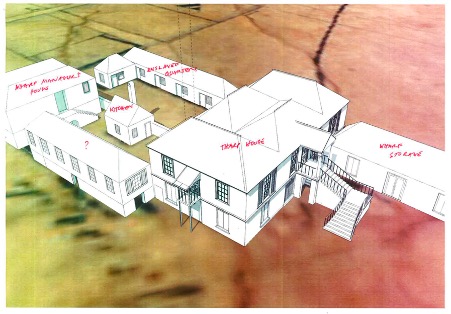The FGSJ has long been working with stakeholders on the project to restore and find a use for this historic Falmouth building. Once the Falmouth residence of John Tharp, more recently the town’s Tax Office, the building is now owned by the Port Authority of Jamaica (PAJ).

The initial phase was carried out over ten years ago by Falmouth Heritage Renewal (FHR) when Robin Dukes, a UK conservation contractor, visited and spent time with FHR trainees, showing them how to carry out proper conservation timber repairs, retaining as much of the original Bullet wood as possible and using the same timber in repair.
The house then remained dormant for about the next eight years when repairs to the remaining upper floor framing and the renewal of the roof structure and covering were carried. Unfortunately, all the Bullet wood framing was replaced with treated Pine. Much useful evidence and information has therefore regrettably been thereby lost.
The current phase involves repairs in the ground floor chamber including consolidation of the external masonry walls, repairs to the supporting timber columns and the repair of the upper floor beams and joists. Dr Ivor Conolley is overseeing this third, consolidation, phase, on the house. The works required for its completion and fitting out will include plastering, masonry, carpentry, joinery, metal work and decoration. These will provide considerable opportunities for training in the various trade skills.
The FGSJ has recently provided technical advice on how to support an external masonry wall and the order of work in order to obtain best results. In January 2024, an FGSJ team advised on the makeup of stucco and plaster mixes for external and internal walls, and physically sorted through salvaged elements of joinery trim to produce packages of material which can be reused on cornices, architraves etc.

The PAJ has asked the director of the Jamaican National Museum to produce a considered proposal for the use of the house as a ‘Museum of Falmouth’.
There has been a shared wish that the house and its surroundings should be a Site of Memory, and that the area where archaeology suggests the quarters for the enslaved people were housed might become a garden of remembrance.
